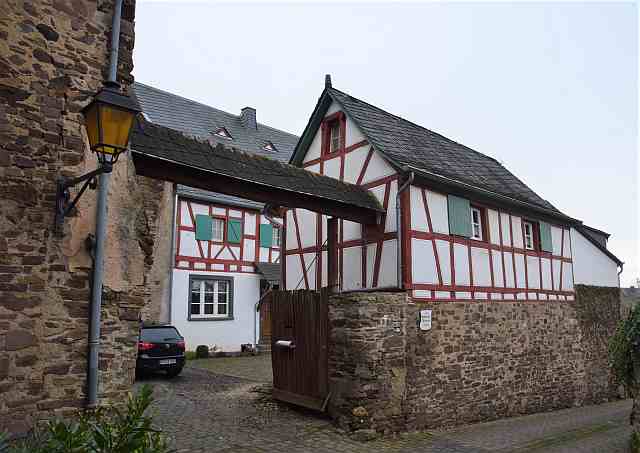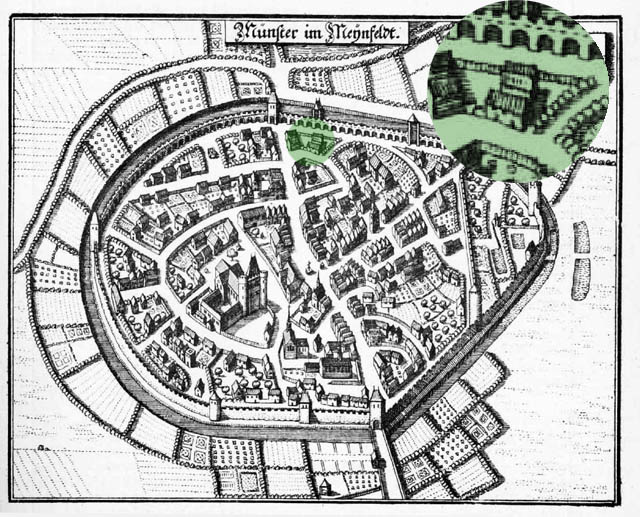14. Rother Hof (Rother Farm)
Built in 13th /14th century
Presumably in the succession of the lords
of Schöneck, the Rother Hof was owned
by the Archibishops of Trier
until 1654.
This farm was sold by archbishop Karl Kaspar von der Leyen in 1654. The archbishops are to have taken it over at an unknown time from the lords von Schöneck. There were two “von Schöneck” families, who had their family seats in the Eifel and in Hunsrück. Both noble families were in the service of the archbishop of Trier in the 13th/14th century. The name could refer to a farm that was designed for the clearing.
Let's start with what we know for sure. The Rother Hof

was sold in 1654, together with Schoenecker Burg and the "Alte Kellerei", by Elector Carl Caspar von der Leyen (1652-1676) to the electoral "Kellner" Heinrich von Ufflingen. The deed of sale contains the only record of the farm's name to date. The farm is located near the fortified tower at the Obertor, directly on the city wall.

We can be fairly certain that the oldest preserved components, such as the barn wing with Gothic gable, date from the 14th century. The name Rother Hof refers to clearing, so it could have been a clearing farm. A Rother Hof lies not far away in the former Eltzer Bann near Wierschem. The location of this farm in the forest on the heights of the Eltz makes the name understandable. This does not apply to the farm at the town wall in Münstermaifeld.
Unless, of course, the farm is older than the wall. This brings us to our chronicler Büchel, who wrote about this farm in 1816: "The ancient Rother Hof building, which farm belonged to the Hauß Schönecken in the Eifel". Büchel describes 192 buildings in the town. As soon as he loses the certainty of written evidence, he speaks of "old" houses". Only twice does he use the classification "ancient", as with the Rother Hof.
According to the chronicler Büchel (1816), this farm is said to have been built by the Lords of Schöneck. There were two families of Schöneck. One, mentioned by Büchel, had its castle (Bellacosta) in the Eifel above the valley of the Nims near Prüm. The other had its ancestral castle in the Hunsrück above the Ehrbach valley near Boppard. Only for these Schoeneckers from Hunsrück can connections to Münstermaifeld be proven. In the 14th century, they were closely connected to the monastery as canons and provosts. A Conrad von Schöneck, from the Hunsrück house of Schöneck, was Schultheiss in Münstermaifeld in 1306/07. Both noble families only came into being in the 13th century, the Hunsrückers 1224-1508, the Eifelers 1264-1370. It is known that the two houses were often confused. We do not know when and under what legal title, whether as own or as fief, the Schöneckers sat on the farm. Whether the name of the farm refers to a clearing activity remains to be clarified. In the context of the search for an explanation for the farm name, the series of surviving epithets of the Schoeneckers from the Hunsrück is interesting. In the period from 1250 to 1370, three generations of the lords of Schöneck succeeded one another, who, in addition to the name Konrad, bore the epithet der Rote (also Rode or Rothe). This was the period in which the Schöneckers from the Hunsrück were closely connected with the town and the monastery. This is also a possible period for the construction of the farm. Whether the name of the farm, corresponding to the numerous "red houses", so there was also a "red house" in Münstermaifeld in 1569, ultimately only refers to a colour, should only be mentioned as a possibility. Another clue could be proven field names in the district of Münstermaifeld. For example, there is the name "in den Rotherder Wiesen" with reference to the "Roterde Bach" and "im Rothen Suller". However, neither of these field names is spatially connected to the farm. There were farms of foreign lords in Münstermaifeld who competed with the archbishops for lordship rights in and around Münstermaifeld until the 15th century. We know of a court of the Counts of Virneburg and a Sponheim court. These courts, which brought with them dominion over the land and people, prevented the archbishop from completely dominating the town for a long time.
Glossary
Balduin
Archbishop and Elector of Trier (1307-1354). Balduin from the House of Luxembourg, brother of the German King and Roman Emperor Henry VII. (1308-1313), uncle of King John of Bohemia and great-uncle of the German King and Emperor Charles IV (1346-1378), was one of the most influential imperial princes in the first half of the 14th century. During his reign, Münstermaifeld became an important outpost of the territorial policy of the Archbishop of Trier. Thus the completion of the construction of the collegiate church was also a demonstration of Trier's presence vis-à-vis neighbouring Cologne. The reinforcement of the town fortifications confirmed the importance of the Münstermaifeld office for securing the rule of the Trier archbishops. The enforcement of the land peace protected urban development against encroachments by the nobility.
Karl Kaspar von der Leyen
Archbishop of Trier 1652-1676. He had to rebuild the country destroyed by the Thirty Years' War. Among his merits was the order to end the witch hunts in the archbishopric. For Münstermaifeld and the 26 known victims of the witch mania, this order came too late.
"Kellner"
He was responsible for the administration of monetary and in-kind duties to the sovereign.
Büchel
On the life of Johann Büchel V. (1754-1842) see Büchel House. He is to be presented here with his work as a chronicler. He held a wide variety of municipal offices. He was therefore very well informed and had access to sources that no longer exist today, dating back to the 16th century. In his biography, which he began in 1828, he lists 58 titles of his manuscripts. Among them are the 12 chronicle volumes that are indispensable for researching the history of Münstermaifeld and the Maifeld. They were written between 1811 and 1828.
Canon
The governing body of the monastery was the chapter, the assembly of the canons. Numerous conditions had to be fulfilled to become a full member. Ordination to the priesthood was not a prerequisite for admission to the chapter. The canon's official position was called prebend. The number of resident canons varied between 12 and 16. Only members of the chapter could become holders of special dignity and responsibility, such as dean. Recommendations for admission as canons came from the archbishop, the pope or even the king.
Provost
The provost represented the monastery externally. He had to defend the rights, goods and income of the monastery and preside over the tribunal. The provost had his own rights, duties and income vis-à-vis the chapter. Until 1515 he was elected by the chapter and confirmed by the archbishop. Papal recommendations were often decisive for filling the office. After 1515, the office of provost was an additional dignity and source of income for the archbishop of Trier.



